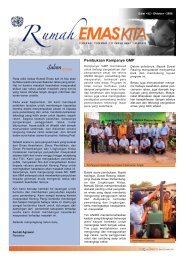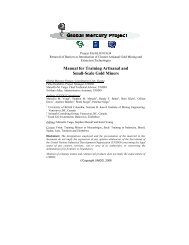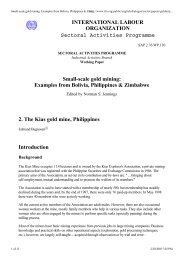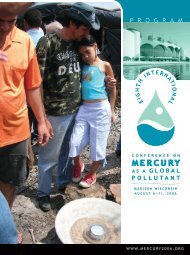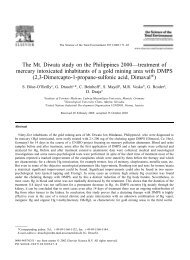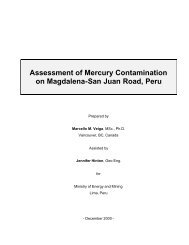ARTISANAL AND SMALL-SCALE GOLD MINES IN BURKINA FASO ...
ARTISANAL AND SMALL-SCALE GOLD MINES IN BURKINA FASO ...
ARTISANAL AND SMALL-SCALE GOLD MINES IN BURKINA FASO ...
Create successful ePaper yourself
Turn your PDF publications into a flip-book with our unique Google optimized e-Paper software.
environmental problems, and to draw up an efficient intervention strategy for limiting future harm.<br />
WORRY<strong>IN</strong>G HEALTH <strong>AND</strong> SAFETY ASPECTS<br />
Working conditions on artisanal gold mining sites are commonly high-risk and very hard, especially for the<br />
women and children who are omnipresent in the processing areas. Mortal or disabling accidents, though<br />
rarely declared, are common on the mine sites. They occur during ground collapse, rock falls, and flooding,<br />
and caused by badly propped-up pit walls, pillars that are too small, irregular pumping, the piling up of<br />
waste too close to the pits, and poorly controlled use of explosives (like in Ghana, with a slow fuse and<br />
matches). The last disaster given media coverage was in November 2001 at Guéguéré (Ioba Province),<br />
where a pile of waste slid into a trench, officially burying 35 miners. Other, more long-term, hazards to<br />
miners come from operating and ore-processing conditions. Their impact may be particularly heavy on<br />
women, sometimes pregnant, and the small children with them. The inadvertent exposure to rock dust, as<br />
well as to vapours from chemical products such as mercury, but also nitric acid 8 , can have disastrous<br />
consequences such as severe neurological or lung diseases. Other, less severe, hazards include fumes<br />
escaping from the mills, noise and vibrations.<br />
During a rush, the living conditions for the entire mining community on a site can become dramatic.<br />
Such communities commonly are cut off from all educational or health structures, in a temporary camp that<br />
quickly becomes overpopulated and filthy, and where promiscuity is extreme: malnutrition, precarious<br />
housing, a lack of drinking water, the absence of sufficient sanitary installations, all favour the development<br />
of epidemics. In 1998, the Mogrenore site (Tiba District, Boulgou Province) became a cholera vector that<br />
spread near to Ouagadougou (Toux and Thomassin, 1999). In 2002, living conditions at Nagrigré<br />
(Zoundweogo province) made the authorities fear a similar outbreak. To this must be added the fact that<br />
children do not attend school (they start at a very young age participating in artisanal gold mining work),<br />
and the excessive consumption of alcohol and drugs (Nigerian “Blue-Blue” or “C14” amphetamines), and<br />
prostitution serve as fertile soil for criminality and AIDS.<br />
WHAT IS THE BEST DEVELOPMENT POLICY?<br />
Faced with such economic and social stakes, choosing the right development policy is far from easy.<br />
Would it be better to provide direct assistance to the traditional artisanal activity, or should one foster the<br />
emergence of small enterprise that can disseminate better methods? Obviously, the role of an artisanal<br />
mine in sustainable development will be quite variable. Moreover, the approach of providing support to a<br />
community commonly is in conflict with providing support to a small mine. How to decide between these<br />
two complementary approaches? An additional problem is that budget restrictions often force ‘triage’: the<br />
support-of-communities approach entails the risk of too selective humanitarian-type assistance, but the<br />
small-mine-support approach not uncommonly results in a few opportunistic persons profiting from the<br />
development-aid funds, which, in the first case, at least are more equitably distributed (Jaques et al., 2003).<br />
Regardless of the selected option, the resulting actions must imperatively be of suitable duration (i.e. at<br />
least 4 to 5 years), and should privilege a general and participative approach to address absolutely all key<br />
problems, whether social, cultural, technical, economic, financial, or environmental. Joint actions for<br />
strengthening the institutional services and organizations in charge of the sector are of paramount<br />
importance. It can be said that:<br />
- Any assistance for Burkina artisans, thus addressing more than 100,000 individuals, must be based on<br />
immediate-assistance actions, coupled with long-term prevention and educational actions.<br />
- Any assistance of small-mine entrepreneurs in Burkina, addressing at most a hundred individuals, must<br />
be based on short- to medium-term actions of expert assistance, and formal on-the-job training.<br />
8 Hot nitric acid locally is used after flotation for the roasting of sulphuric oxides and the liberation of gold from concentrates.<br />
10



